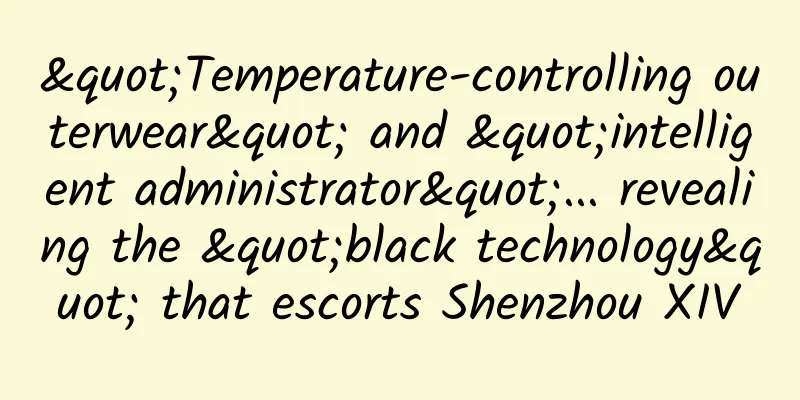"Temperature-controlling outerwear" and "intelligent administrator"... revealing the "black technology" that escorts Shenzhou XIV

|
The Shenzhou 14 astronaut crew successfully entered the Tianzhou 4 cargo spacecraft, and related work is proceeding as planned. In this flight mission, what "black technology" escorted the Shenzhou 14 spacecraft? On June 5, the Beijing Aerospace Flight Control Center took a picture of the Shenzhou XIV manned spacecraft and the Tianhe core module autonomously and quickly rendezvousing and docking. Photo by Xinhua News Agency reporter Li Xin Regardless of the extreme heat or cold, the "temperature-control outerwear" protects astronauts from cold and heat The docking mode of the Shenzhou XIV spacecraft and the flight posture of the space station combination will cause the spacecraft to be continuously blocked by other cabins, causing the spacecraft to be in an extremely low temperature environment for a long time without being exposed to the sun, with the lowest temperature even below minus 100 degrees Celsius. When the space station is in certain configurations, local areas of the spacecraft will continue to be irradiated by the sun, with the highest temperature exceeding 100 degrees Celsius. The extreme high and low temperature environment outside has brought severe tests to the health of astronauts and the normal operation of spacecraft equipment. To address this temperature control challenge, engineers from the Fifth Academy of China Aerospace Science and Technology Corporation took advantage of the fact that thermal radiation is the main method of heat conduction in outer space, and made breakthroughs in key technologies such as the selective design and regulation of the photothermal performance of spacecraft outer thermal control coatings, the spatial stability design of thermal control materials, and the combined control of large and complex structure interfaces. They designed and developed a magical "temperature control coat" - a low-absorption, low-emission thermal control coating. Low absorption, as the name suggests, means that the coating itself has a low solar absorption characteristic, which can effectively reduce the temperature rise caused by solar radiation. Low emissivity means that the coating has a low infrared emissivity, which can effectively block the radiation heat leakage from the interior of the spacecraft to the external deep-cold environment, thereby preventing the temperature in the cabin from continuing to drop. At the same time, engineers have made specific designs for the absorption and emission performance based on the spacecraft structure, power and space thermal environment characteristics. The resulting "temperature-controlled outer coat" can ensure that the spacecraft can maintain a suitable temperature range inside the cabin even in long-term extreme high and low temperature external environments, thereby protecting the astronauts from cold and heat and safeguarding their safety. On June 5, the Beijing Aerospace Flight Control Center took a picture of the Shenzhou XIV manned spacecraft and the Tianhe core module autonomously and quickly rendezvousing and docking. Photo by Xinhua News Agency reporter Li Xin Don’t worry about the massive amount of data, “smart administrator” can help Massive amounts of data are generated all the time on the Shenzhou XIV spacecraft. In order to convert these complex parameters into intuitive numerical values that astronauts can understand, the instrument controller application software will act as an "intelligent manager". When the various subsystems of the spacecraft start to operate, the data generated will be collected in the digital control subsystem, and then summarized by the "intelligent administrator" and converted into content that astronauts can intuitively identify and operate and displayed on the instrument. There are more than 50 pages on the Shenzhou XIV spacecraft showing the conditions of various parts of the spacecraft. According to the needs of the manned rendezvous and docking mission, relevant content including the world map and the physical condition of astronauts are displayed. These are all provided by the instrument controller application software which acts as an "intelligent administrator". The instrument controller application software uses unique graphic display technology to display the spacecraft trajectory, attitude, flight status and subsystem information through text, graphics and animation. Zhang Chiping, an application software designer for the Shenzhou 14 spacecraft instrument controller at the Xi'an Branch of the Fifth Academy of China Aerospace Science and Technology Corporation, said that the use of this unique graphic display technology can not only produce novel instrument controller display effects, but also realize the processing and display of graphics and text in space intelligent instruments, providing astronauts with a clear, intuitive and comfortable display interface to perform their missions. On June 5, at the Beijing Aerospace Flight Control Center, aerospace researchers were monitoring the autonomous rapid rendezvous and docking of the Shenzhou XIV manned spacecraft with the Tianhe core module. Photo by Xinhua News Agency reporter Li Xin No matter how long the journey is, the "sky road" in space is always open The Shenzhou XIV spacecraft soared into the sky. How did it achieve "space-earth communication" with the ground at such a long distance? The answer is the space "sky road" built by the Xi'an Branch of the Fifth Academy of China Aerospace Science and Technology Corporation through a relay terminal. When the Shenzhou XIV spacecraft entered the planned orbit, the spacecraft relay terminal began to work. According to the command chain requirements of the spacecraft flight program, the equipment in the relay terminal will calculate the directional data of the relay terminal antenna. Afterwards, the rotating device in the relay terminal points the relay antenna to the Tianlian relay satellite. This completes the capture and tracking of the Tianlian relay satellite, establishes a communication link from the spacecraft to the Tianlian relay satellite and then to the ground, realizes smooth communication between the Shenzhou XIV spacecraft and the ground, and ensures that the test personnel on the ground can grasp the flight status of the spacecraft in real time. Yu Xiaochuan, head of the manned space mission of the Xi'an Branch of the Fifth Academy of China Aerospace Science and Technology Corporation, introduced that the space-based measurement and control communication system established through the relay terminal and the Tianlian relay satellite can increase the ground measurement and control coverage of the Shenzhou XIV spacecraft to more than 90%. Reporter: Hu Zhe, Song Chen Source: Xinhua News Agency |
<<: Beidou’s application in space services: Beidou satellites, guiding beacons for spacecraft
Recommend
The efficacy and function of blue stone ginseng
Blue flower stone ginseng is a very common Chines...
The efficacy and function of sheath flower
The medical value of the sheath flower is beyond ...
The role and efficacy of Smilax glabra
There are many common foods in life. Foods can no...
What are the medicinal values of Sumatran serow?
Although the Sumatran antelope is called an antel...
This common "birthmark" may be a disease: "coffee spots" that cannot be ignored
Coffee-fronted spots are a common "birthmark...
Eating less sugar can really prevent cancer!
This article was reviewed by Dr. Guo Xiaoqiang, a...
What foods don't taste salty, but are high in salt? In fact, every kitchen has them...
Everyone now advocates a low-salt diet Very sensi...
Insomnia, what is our body telling us?
Some people say that after the age of 30, you can...
What are the effects of Cordyceps Ginseng?
Cordyceps ginseng has a very good regulating effe...
What is the relationship between the "different world" of karst caves and groundwater?
recently In Nalangtun, Bamu Township, Tian'e ...
What are the medicinal values of mother of pearl?
We all know that natural pearls grow in the shell...
She protected 242 gorillas and spent her life alone in the forest
In the early morning of December 27, 1985, zoolog...
Effects and functions of hibiscus seeds
I wonder if you have ever heard of hibiscus seeds...
The efficacy and function of peony root
Everyone is familiar with the root of peony. It h...
Can contact with shopping receipts cause cancer? Is bisphenol A in machine-printed receipts really that scary?
gossip "Bisphenol A in machine-printed recei...









